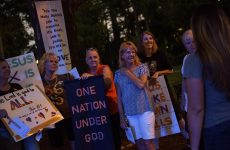
Early on in “Narrative of the Life of Frederick Douglass,” the first of three autobiographies Douglass wrote over his lifetime, he recounts what happened—or, perhaps more accurately, what didn’t happen—after his master, Thomas Auld, became a Christian believer at a Methodist camp meeting. Douglass had harbored the hope that Auld’s conversion, in August, 1832, might lead him to emancipate his slaves, or at least “make him more kind and humane.” Instead, Douglass writes, “If it had any effect on his character, it made him more cruel and hateful in all his ways.” Auld was ostentatious about his piety—praying “morning, noon, and night,” participating in revivals, and opening his home to travelling preachers—but he used his faith as license to inflict pain and suffering upon his slaves. “I have seen him tie up a lame young woman, and whip her with a heavy cowskin upon her naked shoulders, causing the warm red blood to drip; and, in justification of the bloody deed, he would quote this passage of Scripture—‘He that knoweth his master’s will, and doeth it not, shall be beaten with many stripes,’ ” Douglass writes. Douglass is so scornful about Christianity in his memoir that he felt a need to append an explanation clarifying that he was not an opponent of all religion. In fact, he argued that what he had written about was not “Christianity proper,” and labelling it as such would be “the boldest of all frauds.” Douglass believed that “the widest possible difference” existed between the “slaveholding religion of this land” and “the pure, peaceable, and impartial Christianity of Christ.”
Yet, a hundred twenty-five years after Douglass’s death, the American church is still struggling to eradicate the legacy of the slaveholding religion he loathed. In a 2019 nationwide survey, eighty-six per cent of white evangelical Protestants and seventy per cent of both white mainline Protestants and white Catholics said that the “Confederate flag is more a symbol of Southern pride than of racism”; nearly two-thirds of white Christians over all said that killings of African-American men by the police are isolated incidents rather than part of a broader pattern of mistreatment; and more than six in ten white Christians disagreed with the statement that “generations of slavery and discrimination have created conditions that make it difficult for blacks to work their way out of the lower class.” In his new book, “White Too Long” (Simon & Schuster), Robert P. Jones, the head of the Public Religion Research Institute, a nonpartisan polling and research organization, marshals this and other data to lay out a startling case that “the more racist attitudes a person holds, the more likely he or she is to identify as a white Christian.” The correlation is just as pronounced among white evangelical Protestants as it is among white mainline Protestants and white Catholics—and stands in stark contrast to the attitudes of religiously unaffiliated whites. Jones’s findings make for some wrenching inferences. “If you were recruiting for a white supremacist cause on a Sunday morning, you’d likely have more success hanging out in the parking lot of an average white Christian church—evangelical Protestant, mainline Protestant, or Catholic—than approaching whites sitting out services at the local coffee shop,” he writes.
Much has been made of white evangelicals’ support for Donald Trump in the 2016 election. (According to exit polls, eighty-one per cent of white evangelical Protestants voted for him.) Less attention has been paid to the fact that sizable majorities of white Catholics (sixty-four per cent) and white mainline Protestants (fifty-seven per cent) also backed him. In November, President Trump will once again be reliant upon the white Christian vote if he hopes to defeat his Democratic opponent, former Vice-President Joe Biden. Trump’s racism has defined his Presidency—driving his exclusionary immigration policies, his Twitter tirades, his reluctance to condemn white-nationalist protesters in Charlottesville, and his scapegoating of China for the coronavirus pandemic. Yet polls show that most white Christians continue to approve of his job performance. It is a perplexing, distressing trend, one that may be irrevocably damaging to the church, as increasing numbers of people, particularly millennials, leave Christianity. In December, when Mark Galli, who was then the editor-in-chief of Christianity Today, the flagship publication of evangelicalism, wrote an editorial calling for Trump to be removed from office, he urged Christians to consider how their support of Trump influenced their “witness”—the degree to which their lives point to the example of Jesus Christ. “Consider what an unbelieving world will say if you continue to brush off Mr. Trump’s immoral words and behavior in the cause of political expediency,” he wrote. “If we don’t reverse course now, will anyone take anything we say about justice and righteousness with any seriousness for decades to come?”
In some sense, Trump’s Presidency has merely given modern form to racist attitudes that have long festered in American Christianity. In his book “The Color of Compromise” (Zondervan), published last year, the historian Jemar Tisby traces the revivalist origins of evangelicalism in America, and notes how the movement’s emphasis on individual conversion and piety constrained its social vision. The evangelist George Whitefield, who was instrumental in the Great Awakening, in the early eighteenth century, condemned the cruelty of slaveowners but campaigned for slavery’s legalization in the colony of Georgia. The theologian Jonathan Edwards pressed for the evangelization of the enslaved but owned several slaves; he believed the practice could be countenanced as long as they were treated humanely. “Within this evangelical framework, one could adopt an evangelical expression of Christianity yet remain uncompelled to confront institutional injustice,” Tisby writes.
In the early nineteenth century, the Second Great Awakening, which brought with it a moral fervor to perfect human society, helped spark abolitionism and other reform movements. Even outspoken critics of slavery, however, remained committed to the entrenched racial hierarchy. Charles Finney, an influential revivalist preacher and abolitionist, barred slaveholders from taking communion in his churches, but he opposed the intermingling of races and prohibited Blacks from holding church office. For Finney, social reform was always secondary to the ministry of the Gospel. “When I first went to New York, I had made up my mind on the question of slavery, and was exceedingly anxious to arouse public attention to the subject,” he writes in his memoir. “I did not, however, turn aside to make it a hobby, or divert the attention of the people from the work of converting souls.” In the South, church leaders developed an elaborate system of scriptural justifications for slavery. A Baptist pastor in Alabama, the Reverend Dr. Basil Manly, Sr., became the country’s leading religious voice in support of the institution, playing a central role in the establishment of the Southern Baptist Convention—formed in the aftermath of the Baptists’ schism over slavery—and delivering the invocation when Jefferson Davis was inaugurated as President of the Confederacy.
After the South’s defeat in the Civil War, Southern church leaders struggled to help their congregants make sense of their loss. The result was the religion of the Lost Cause, a mythology that ennobled the Confederacy and idealized the antebellum South as a bastion of Christian piety and morals. This fusion of religious and cultural values, delivered from the pulpit, helped to legitimize a social order that continued to subjugate Blacks. Later, as evangelical Christianity, anchored in the South, grew to become the dominant expression of Christianity in America, its cultural scaffolding, rooted in white supremacy, spread as well. During the era of Jim Crow, when Southern statutes enforced the strict separation of races and restricted the rights of Blacks, Northern Protestant churches remained largely segregated and muted in their criticism. Many white Christians saw segregation as simply part of God’s plan for humanity.
During the civil-rights era, even as Black clergy became prominent leaders in the movement, few white church leaders fully embraced it. The Reverend Billy Graham held racially integrated revivals and criticized segregation at his meetings, but the primacy of his evangelistic mission—and his desire for the widest possible audience for it—made him cautious. During a crusade in Jackson, Mississippi, in the summer of 1952, he told the audience that segregation had no place in the church. “There is no scriptural basis for segregation,” he said. “The ground at the foot of the cross is level.” But when his remarks drew the ire of white Southerners, he equivocated. “I came to Jackson to preach only the Bible and not to enter into local issues,” he told the local newspaper. Graham would later invite the Reverend Dr. Martin Luther King, Jr., to deliver the opening prayer at a crusade in Madison Square Garden, but he refrained from a full-throated endorsement of King’s movement. In April, 1963, shortly after King wrote his “Letter from Birmingham Jail,” Graham declined to characterize himself in an interview with the Times as a “thoroughgoing integrationist,” and said that the civil-rights protesters ought to “put the brakes on a little bit.” In his autobiography, “Just as I Am,” Graham writes that King encouraged him to “stay in the stadiums, Billy,” because his impact would be greater there. King also told Graham that “if a leader gets too far out in front of his people, they will lose sight of him and not follow him any longer.” Graham wrote that he followed King’s advice.


